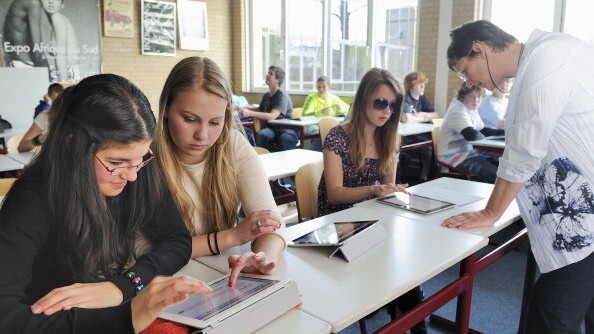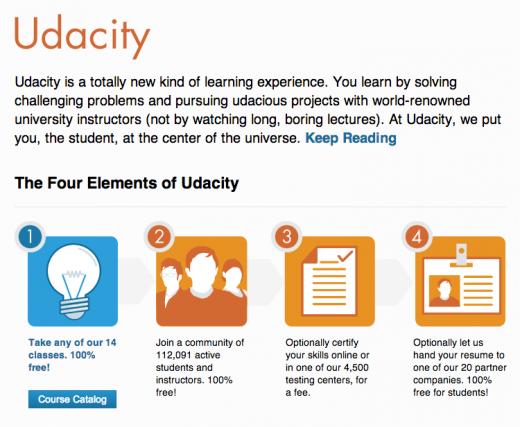
Udacity, a startup dedicated to helping to democratize education and make it available online to the masses, has just raised $15 million for its Series B round of funding from Andreessen Horowitz.
Peter Levine, the investing partner for the firm, will be joining Udacity’s board. With this latest investment, the company has raised over $21 million and Andreessen Horowitz joins Charles River Ventures and Steve Blank as backers of this nearly two-year-old company.
What is Udacity?
In case you haven’t heard about Udacity, it is a company focused on merging education with technology to help make learning accessible, engaging, and effective to the world. The founders believe that higher education is a basic human right and hope to “empower students to develop their skills in order to advance their careers.”
Since its launch in January, it has over 753,000 students signed up and learning online.
All courses are free for students to take and it can be done at their leisure. There are currently 14 different classes that students can enroll in — all related to technology: Introduction to Computer Science, Web Development, Interactive Rendering, Artificial Intelligence, HTML5 Game Development, Applied Cryptography, and much more.

Once you’ve signed up for a course, you can engage with the Udacity community for support and to build friendships and relationships. If you’d like, skill certification is available to help you advance yourself professionally in the workplace.
Sebastian Thrun, one of Udacity’s founders, who just also happened to lead the team that invented the Google self-driving car, is a professor at Stanford University. He told us that he realized that when not all of his students showed up for class and relied on learning through an online medium, grades went up. It made Thrun a bit humbled and so he believes that it’s a nice compliment if we can take the lecture outside of the equation — it would free up the teachers to focus on better education.
Not only that, but with the rising cost of education and the current budget cuts to schools, the system is in shambles and students long for additional outlets to learn. Udacity offers up a vital service in order to help them remain competitive in their desired profession.
With Udacity, students are able to learn skills that are relevant now, and also are things that are constantly evolving. In a traditional institution, students won’t be taught HTML5 because it’s brand new. The curriculum just hasn’t adjusted for the new skills out in the workforce — this startup helps fill the gap and better prepares a student for work.
Another benefit that the service brings is job placement. Once you’ve gone through a particular course or a series of courses, you can get yourself certified and then update your resume for companies interested in finding developers or those with necessary skills right on the site. There are at least 20 companies partnered with the service to find qualified applicants — something that they might not be able to find in the traditional institutions.
While the courses are free, the company has been making money by having new partners sign up and help to develop new courses. So, for example, if a company is in search of HTML5 developers, they might contact Udacity and help create the curriculum that would benefit both the industry and themselves. Partners can also pay the service to help them find the right workers for their company.
The future of Udacity
With this new round of funding, Thrun said that the company will focus on enhancing its curriculum to bring on more courses. Additionally, the service will expand so that it can be brought to other parts outside of the United States — currently two-thirds of all signups are from outside the country. More staff will be brought on board to help support education.
For Andreessen Horowitz’s Levine, previously a teacher at Stanford, he believes that through technology, education is going to undergo a major transformation. The way students have been taught has been the same since forever. Now, we’re at a point in time where technology access and course content have a chance to merge together to augment reality.
As Levine said in his post announcing the investment:
There is a supply and demand problem in that the demand for quality education is not being met by an adequate supply of learning opportunities. From a technology perspective, this is a problem that can be solved with software. From a societal perspective, there should be alarm bells going off for everyone that this is an issue that requires our boldest ideas and brightest minds…we believe the next big disruptive trend in software will focus on education and we feel that [Udacity] is the team that will lead the way.
Thrun said that with Andreessen Horowitz on board, “We can materially change the lives of millions of students in the world, and we are excited to do so with a world-class team of investors.”
Image credit: LEX VAN LIESHOUT/AFP/Getty Images
Get the TNW newsletter
Get the most important tech news in your inbox each week.




